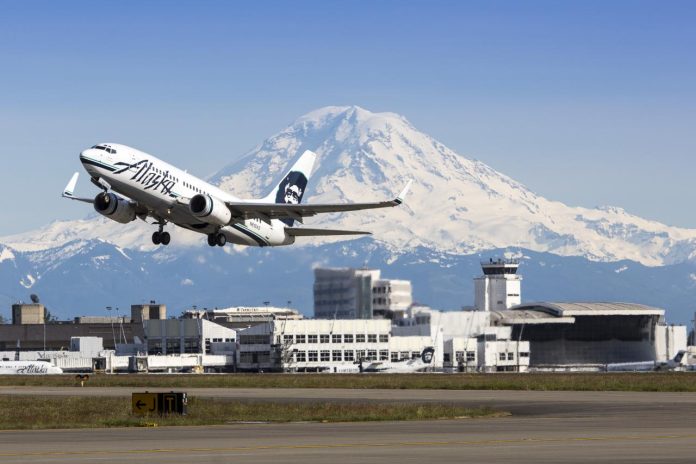
If you sit on the Seattle waterfront on a sunny spring day you can hear a rumble in the distance. No, it’s not the new waterfront highway built where the old highway Viaduct used to be — and on top of the old-new highway buried deep underground in a tunnel. Let’s imagine you took the Elliott Bay Trail a little farther than that and found a nice quiet place to enjoy the sun in peace and quiet. But there is that rumbling, a predictable beating of the drums for a new transportation megaproject. Today it is not a pointless, backwards-minded freeway expansion project (pick your favorite), but instead a brand new airport for the growing population of the Puget Sound region.
The ongoing expansion of Seattle Tacoma International Airport is racing to keep up with demand for cargo and people movement by air, and a 2019 study by the Puget Sound Regional Council (PRSC) shows demand doubling by 2050 and outstripping the capacity of SeaTac’s three runways. While the Seattle Times’ editorial board has picked up the drum beat of SeaTac expansion, a commission of the Washington State Legislature, in parallel to the PSRC study, is already shopping for sites for a new airport.
However, the commission’s own report shows that a majority of Washingtonians (who responded to their surveys — let’s be careful considering this a complete snapshot of public opinion for either people for or against a new airport) were either completely against expanding airports (19.74%) or supported airport expansion as long as environmental impacts are mitigated (36.09%).
On top of that, the Covid-19 pandemic caused a sharp drop in air travel with a recovery that looks likely to delay the timelines reported in the PSRC study by several years. We may not be back at 2019 levels until 2024, according to airline projections.
So here is the pitch: mitigate airport externalities before forcing through another three giant runways in the Puget Sound.
Let’s mitigate the noise impacting neighbors of SeaTac (and in growing amounts Paine Field) before sending jets screaming over new neighborhoods. Expanding the current sound insulation program into a proactive sound and energy retrofit program (where thicker walls and windows provide warmth and quiet) would also bring indoor air quality and climate benefits with it.
We should also mitigate the carbon emissions of air travel from Washington State by decarbonizing the fuel we fill the planes with before we build a whole new airport. Fully electric commercial aircraft are a ways off (but maybe within reach in the future, battery chemistry willing) but we know how to make synthetic fuel using renewable sources to split hydrogen from water and various waste streams for carbon right now. As cautioned by 350 Seattle, we have to be careful to avoid synthetic fuels that bring more greenwashing than benefit by using carbon sources that compete with agriculture or use fossil fuels in making the fuel.
Synthetic fuel also comes at a premium, three to five times the cost of good ol’ climate destroying Jet-A fuel, but either the airlines, corporations, and travelers are going to pay that price — or the rest of us are, whether we fly or not — in the form of suffering (along with real economic impacts) from climate change. Instead of the Port of Seattle’s goal of 10% sustainable aviation fuel by 2028, let’s require a 50% mix of truly decarbonized fuel — fuel not from fossil fuels that doesn’t add carbon to the atmosphere — by 2028 across the whole state and 100% decarbonized fuel, again before we consider building a second airport. This technology is already demonstrated in commercial jets with a 50% mix today, and is headed towards 100%.
Finally, we do not have to helplessly (or hopelessly?) chase the trend of air travel demand in a rapidly growing region. Instead, let’s try to meet that demand by other means of transportation with co-benefits. Here I am talking about trains, which are already much more efficient and much easier to electrify. While the Washington State legislature failed to include funding for their “already a great place to start” Amtrak Cascades Long Range Plan in the recently passed Move Ahead Washington transportation package, it did include $150M to get high speed rail started. High speed rail can create up to 20% of extra airport capacity by absorbing demand for shorter flights.
Across the world countries are scrambling to address the carbon emissions from flying. Plans for an additional runway were blocked at Heathrow Airport over concerns about climate change, Europe is bringing back the sleeper train to reduce the carbon emissions from flying across the continent, and people in Sweden have flown 4% less in response to a “flight shame” campaign. Some quick work in Google Maps suggests that a similar sleeper train approach (on a modernized railway) in the US would put San Francisco, Salt Lake City, and Billings in range of overnight train travel.
Closer to home, 350 Seattle has a campaign to halt expansion of aviation and all the carbon emissions and pollution that come with it (see their most recent campaign centered around King County International Airport to have it live up to climate and environmental goals).
Let’s try everything we can to make travel into, around, and from Washington State climate friendly and equitable before we build a second major airport. No matter how loud the drum beat gets or how necessary the boosters make it sound, we have other options available to us. For the sake of our planet’s future, we need to pursue them.

Gregory Quetin
Gregory Quetin is a climate scientist and aerospace engineer with a PhD and bachelor's degree from the University of Washington. He advocates for a city full of housing, commerce, industry, and recreation as ways to increase resilience to climate change and reduce carbon emissions.

